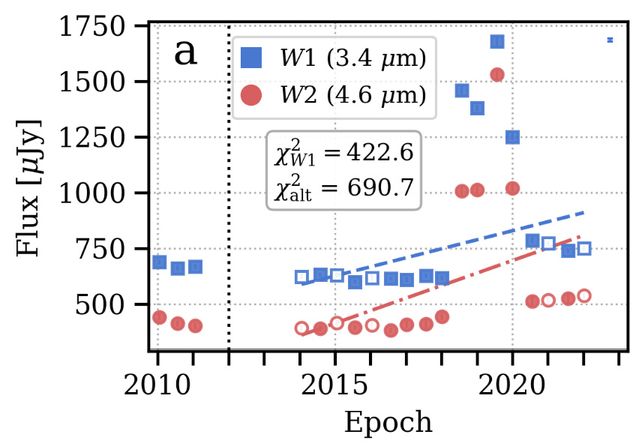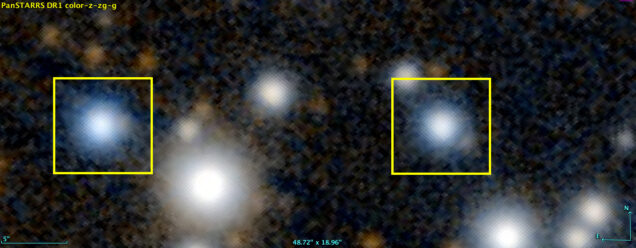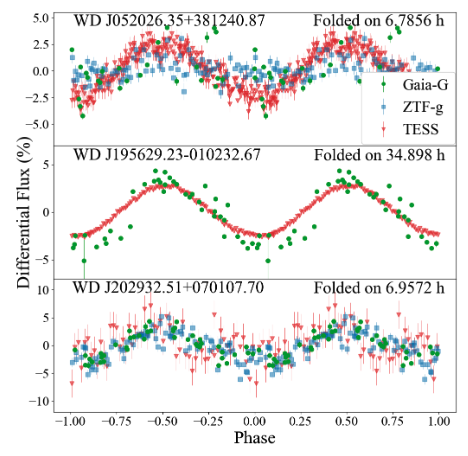News
Transits (that vanish) around a white dwarf every 4.97 hr

In August 2025, a manuscript led by graduate student and BUWD member Joseph Guidry (Guidry, Vanderbosch, Hermes et al. 2025) was accepted which announced the discovery of deep, irregular, periodic transits from rocky exoplanetary debris towards the white dwarf ZTF J1944+4557. This retired star dims by more than 30% roughly every five hours, as clumps of debris block off light from the white dwarf. For the first time we have also observed transits around a white dwarf completely stop, and completely return roughly a year later, giving us a new laboratory to watch how shattered rocks evolve around dead stars. The manuscript has been accepted in The Astrophysical Journal.
Gravitational redshift bias in white dwarf spectra

In August 2025, a manuscript led by graduate student and BUWD member Stefan Arseneau (Arseneau, Hermes, Zakamska et al. 2025) was accepted which showed that substantial biases (5-15 km/s) exist in low-resolution radial velocity measurements, indicating that all the physics of line formation in high-density plasmas is not fully accounted for in state-of-the-art white dwarf model atmospheres. Using large samples from SDSS-V, we attempt to measure this bias and provide simple corrections for surveys like SDSS, DESI, and 4MOST. The manuscript has been accepted in The Astrophysical Journal.
NASA’s Hubble Uncovers Rare White Dwarf Merger Remnant
In August 2025, a manuscript led by Snehalata Sahu at the University of Warwick and including members of the BUWD group (Sahu et al. 2025) announced the discovery of carbon in the atmosphere of an otherwise normal-looking hot hydrogen-rich white dwarf, a tell-tale sign of a merger in the history of the system. The discovery could not have been made without the ultraviolet capabilities of the Hubble Space Telescope. The discovery was featured in a video summary by NASA Goddard, as well as with a NASA/ESA press release and subsequent news coverage by Popular Science and Space.com. The manuscript has been accepted in Nature Astronomy.
Probing Exoplanets Around Massive Stars

In November 2024, a manuscript led by graduate student and BUWD member Lou Baya Ould Rouis (Ould Rouis, Hermes, Gaensicke et al. 2024) was accepted which showed that the most massive white dwarfs (>0.8 solar masses) show metal pollution significantly less frequently than more normal-mass white dwarfs. Specifically, just 11% of white dwarfs that begin their lives as stars >3.5 solar masses on the main sequence show metals from remnant planetary systems, while 44% of white dwarfs that begin their lives as stars <2 solar masses show metals. We have also shown that mergers are unlikely to be the main explanation for this discrepancy. The findings likely have implications for planet formation and/or survival around massive stars on the main sequence which are hard to search for exoplanets using traditional techniques. The manuscript has been accepted in The Astrophysical Journal.
Written in the Stars
A story we ❤️about how exploring the Universe can re-ignite passion. And we don't mind that it's about looking at our white dwarf spectra in @jjhermes.bsky.social group 🤩🔭
www.bu.edu/articles/202...— Sloan Digital Sky Surveys (@sdssurveys.bsky.social) December 12, 2024 at 3:58 PM
BU White Dwarf researcher Ariyana Bonab was featured in a November 2024 video profile by The Brink magazine for her research in Summer 2024 visually classifying more than 50,000 spectra of white dwarf stars from SDSS-V. The five-minute video is well worth a watch!
Signposts of Remnant Planetary Systems

In June 2024, a manuscript led by graduate student and BUWD member Joseph Guidry (Guidry, Hermes, De et al. 2024) took a look at infrared variability of white dwarfs as seen over many years from NASA's Wide-field Infrared Survey Explorer (WISE) space telescope, discovering dozens of new infrared-variable white dwarfs that are likely to be host to remnant planetary systems. Some white dwarfs with planetary systems host dusty debris that causes an infrared excess, and collisions within the debris disks often cause infrared variability. The manuscript has been accepted in The Astrophysical Journal.
Dr. Tyler Heintz

Massive congratulations to Dr. Tyler Heintz, who successfully defended his PhD dissertation on Tuesday July 23, 2024! Tyler has been at BU throughout the entire history of the BUWD research group, and has become expert in the reliability of white dwarf cosmochronology (age-dating white dwarf stars).
EuroWD Conference, July 2024

Three members of the BU White Dwarf group attended the 23rd European Workshop on White Dwarfs, held in July 2024 in Barcelona. We will be hosting the 24th meeting in Summer 2026 in Boston!
Testing Ages Using Spectroscopy of White Dwarfs

In May 2024, a manuscript led by graduate student and BUWD member Tyler Heintz (Heintz, Hermes, Tremblay et al. 2024) announced the most detailed test of white dwarf ages measured from spectroscopic fits in wide WD+WD binaries. By comparing the age estimates of wide pairs of stars that should have both been born at the same time, using fits using both photometry and spectroscopy, Tyler provided one of the most reliable tests of current age-dating methods of white dwarf stars. This work shows that photometry + parallax (distance) measurements returns more reliable results for fainter white dwarfs. It also finds further evidence of a significant merger fraction among wide WD+WD binaries, where roughly 20% are inconsistent with a monotonically increasing initial-final mass relation. The manuscript has been published in The Astrophysical Journal.
Gaia’s Light Curve Prospects

In April 2024, a manuscript led by former BU undergraduate student and BUWD member Maya Steen (Steen, Hermes, Guidry et al. 2024) detailed one of the first systematic analyses of Gaia DR3 multi-epoch light curves, this focused on white dwarfs. Roughly 1300 candidate white dwarfs have Gaia light curves (spanning roughly 1000 days with visits roughly every 44 days). Even with that sparse sampling, Maya (who is now a graduate student at New Mexico State University) showed that periodicities as short as minutes can be detected from the Gaia light curves alone! We discover 86 new objects from the 105 target sample, including pulsating, spotted, and binary white dwarfs, and even a new 68.4 min eclipsing cataclysmic variable. The manuscript has been published in The Astrophysical Journal.